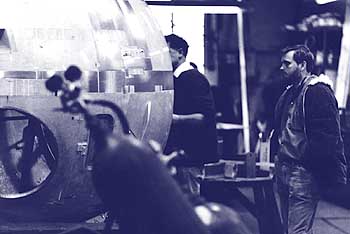Spotlight : April 1998

PART ONE OF TWO
Spotlight : April 1998

PART ONE OF TWO
Introduction by Todd Vaziri
Among the true milestones of science fiction filmmaking is 2001: A SPACE ODYSSEY, Stanley Kubrick's classic 1968 film that redefined the genre. A visual extravaganza, 2001 not only respected the real-life conditions of outer space, but took storytelling to a new level. Still controversial to this day, Kubrick's mesmerizing film opened to mixed reviews, and in the thirty years since its release has since heralded as not just a sci-fi landmark, but as one of cinema's most important films.
A significant contributor to the style of 2001 was Con Pederson, one of the film's special effects supervisors. Currently at MetroLight Studios in Los Angeles (having recently completed work on the HBO miniseries "From The Earth To The Moon"), Pederson sat down with VFX HQ contributing writer Aladino V. Debert to discuss the making of 2001, his relationship with Stanley Kubrick, and the state of visual effects films of today.

Aladino V. Debert: How did you get to meet Stanley Kubrick and work on 2001?
Con Pederson: In 1963 I had written and directed a short film at Graphic Films
Corp. for the 1964 NY's World Fair, and Doug Trumbull was one of the artists on it.
He had done a lot of the space stuff on the film, called TO THE MOON AND BEYOND. It
was a double 70mm projection on a dome, sponsored by Cinerama and KLM. They had built
this theater and they built the projectors, but they didn't have
anything to project for some reason. So I submitted to Graphic Films a little piece we thought might be doable. It was based on traveling up and down the scale we were familiar with, from space to the atom. So we did that in about four months, it was really a rush job, and we got it out in 70mm, and nobody knew was it was actually going to look like in the dome. Anyway, Kubrick had been to the World's Fair and had seen that and was attracted to our company.
I then flew to NY to meet him in the summer of 1965. He had a suite at a hotel near the American Museum of Natural History in the Upper West side of Manhattan, and I remember one entire wall of this apartment were storyboards, that somebody had been doing, filled
Since it was logistically very difficult to do an effects film in Hollywood, Doug and
I left for Britain. At that time they had in England what was called Eady Plan, which
was sort of a subsidy for the British film industry. Under that plan it was permitted
only to have 15 or 20% foreign labor. For the next two and a half years, from mid '65
to March of '68, there was only a handful of Americans working on the film. In our
case it was Doug (special photographic effects supervisor) and myself, and Harry Lange (production design), who was coming from what was going to become NASA, the place where I was stationed in the Army; the Redstone Ballistic Missile Agency in Alabama.
He was one of their main designers. So he and Anthony Masters, the art director, did
most of the work in designing the craft and the look of the film.
There was also
another art director, Ernest Archer, who was actually injured in the Namibian desert
while shooting the "Dawn of Man" in '67. This sequence was shot by projecting 8 by 10
plates into a 70 foot screen in the biggest stage in the studio. These plates were
shot in Southwest Africa. Then they built foreground material on the set that matched the background plates.
predominantly with effects and views of other worlds. I read the script at that time, and it was very exciting... I was blown over by it. The script itself was going to change a lot in the following year with a lot of modifications. Since he and Arthur C. Clarke were writing it together, they were changing it as they went along. I was hooked.

Stanley Kubrick, discussing the Star Child sequence.
Back to the Spotlight Main Menu

. . VFX HQ Produced by Todd Vaziri . . http://www.vfxhq.com . . e-mail: tvaziri@gmail.com . .
All text Copyright © 1998 Todd Vaziri, unless otherwise noted